Potatoes
BackPotatoes are an easy and productive crop to grow in a sunny spot in your garden. A single seed potato can produce 8 or more spuds for harvest in a relatively small space. Plus plantings can be staggered to extend the harvest time and mature potatoes will store for ages so your home grown spuds will last and last.
The best potatoes to grow are the heirloom varieties rarely seen in supermarkets but are sold by mail order companies like The Diggers Club and Green Harvest. When deciding what to plant, first consider how you like to eat your spuds. If you love mashed potato then look for Pink Eye or Dutch Cream. Or if you prefer them roasted try King Edward or the one Jamie Oliver and Heston Blumenthal always rave about – Maris Piper.
How to Grow Potatoes
You can grow potatoes from those in your kitchen but as potatoes are vulnerable to several diseases it’s best to use ‘certified disease free’ seed potatoes available from nurseries and mail order companies. That way you’ll always be starting from a clean slate.
Choose a sunny position with well drained soil that has been improved by digging through aged manure and compost. Apply some gypsum if your soil has a high clay content.
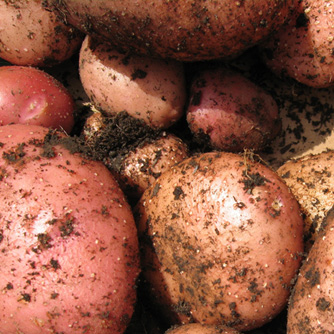
Freshly dug potatoes
Some people like to chit their potatoes before planting. This involves laying the seed potatoes in light (not direct sunlight) until they grow small shoots/sprouts. Others don’t bother with this step and just plant without the shoots. For us both approaches seem to deliver the same result but at least you now know what chitting is
Plant the seed potatoes into trenches 15-20cm deep and about 30-40cm apart. Back fill to cover your potatoes and water in with OCP eco-seaweed. Cover with a layer of sugarcane or pea straw mulch.
Sowing Guide for Potatoes
| Growing Zone | Sowing Time |
| Cool Zones | Spring, Summer |
| Mediterranean Zones | Spring, Summer |
| Warm & Temperate Frost Free Zones | Spring, Summer, Autumn |
| Tropical & Subtropical Zones | Autumn, Winter |
In warm frost free areas potatoes will grow year round but heavy summer rains and humidity can take their toll on plants. We suggest growing during the dryer months for better results.
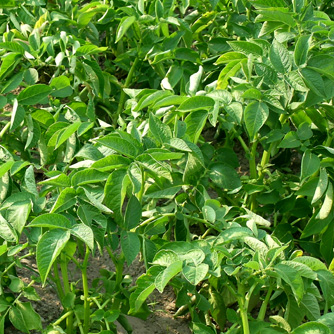
Healthy potato plants
Fertilising Potatoes
Potatoes are hungry plants. The manure and compost dug in before planting should be supplemented with liquid feeding to ensure a bumper crop. Apply OCP eco-aminogro mixed with OCP eco-seaweed every 2-4 weeks to encourage strong healthy plants that will produce loads of potatoes for you.
If growing in poor soil add additional compost, animal manure or certified organic pelletised fertiliser 2 months after first planting the seed potatoes.
Mounding Potatoes
To maximise yields it is common to mound the plants as they grow. This involves pulling back the mulch, partially burying the growing stems with a layer of soil or compost and then returning the mulch. This is repeated several times during the growing period. Mounding encourages greater potato production (extra potatoes develop along the covered stems) and also protects them from sunlight which would turn them green.
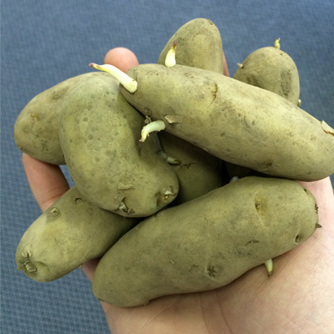
Kipfler potatoes with their distinctive elongated shape
Alternative Growing Methods
If you’ve got limited garden bed space then try growing them in Grow Bags. These are thick woven bags used in production nurseries for growing trees and shrubs. Sometimes they can be found in hardware stores or get them online. The 45L size is ideal.
Place a layer of soil, compost and manure about 10cm thick in the bottom of the bag. Put the seed potatoes on top and then cover with another soil layer and some mulch. Water in with OCP eco-seaweed. When the shoots have broken through and are about 15-20cm tall partially bury them with another soil layer (just like Mounding). Continue this process over several weeks until the Grow Bag is filled with soil. Keep the plants well fed and watered to ensure a good harvest.
If you have plenty of garden space but poorly draining soil then try growing them in a cylinder of chicken wire held upright with 3-4 stakes. This method allows the potatoes to grow upwards and not be vulnerable to rotting in the heavy soil. Make the cylinder with the wire and stakes and fill the base with a mixture of compost, manure and straw about 10-20cm thick. Plant 3-4 seed potatoes and cover them with more of the straw mix.
When the plants grow 15-20cm above the straw mixture add more to partially bury the stems (just like with the Grow Bags). Water and feed the plants and repeat the mounding process to the top of the cylinder. When the leaves die down, remove the chicken wire and harvest your potatoes.
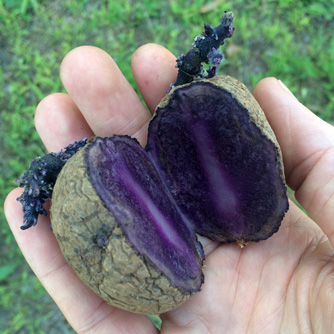
The unusual purple Sapphire potato
Harvesting Potatoes
Potatoes are ready for harvest 12–20 weeks from planting depending on the variety and growing conditions. When the flowers appear you can begin gently “bandicooting” under the plants for baby chat or new potatoes. These small sweet tasting potatoes have soft skins that peel off easily so they should be eaten immediately and not stored.
For full sized potatoes wait 2-3 weeks after the plants completely die down before harvesting. By now they will have a thicker skin which is perfect for storing. During this stage do not keep watering the plants as excess water at this time could cause your precious spuds to rot!
To store your potatoes, gently brush off as much dirt as you can, allow them to dry and then place them in either a hessian sack or cardboard box studded with holes. Keep them in a dry, cool and dark place with protection from vermin. Check them regularly for any soft or rotten potatoes and remove them to prevent further spread.
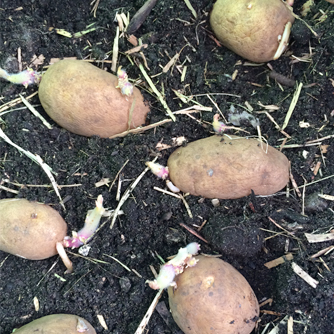
Chitted Nicola seed potatoes with sprouting 'eyes'
Pest & Disease Problems of potatoes
Unfortunately there are many diseases which can attack potatoes and result in major crop losses. The symptoms vary depending on the disease but include rotting stems and tubers, distorted and mottled foliage as well as stunted growth. They can be extremely difficult or impossible to control so the best approach is to take these preventative measures:
- only plant certified disease free seed potatoes. These have been grown in soils and conditions that are free of viral, fungal and bacterial diseases.
- protect new shoots from snails and slugs with OCP eco-shield.
- spray OCP eco-oil at the first sign of whitefly. These pests will weaken growth by sucking sap but they can also spread damaging viruses such as leaf roll.
- watch for other sap sucking pests like aphids and mites which can also cause damage. Spray with a horticultural oil.
- practice crop rotation and never grow potatoes in the same space 2 years in a row to prevent a build up of diseases and soil borne pests. Do not plant potatoes where other members of the solanaceae family (eg capsicums, eggplants, tomatoes and chillies) have previously been growing as they can share the same diseases.
- nematodes are one of the soil borne pests which damage roots and tubers resulting in poor growth and yields. Treat soil with OCP eco-nemguard at planting time and every 4-6 weeks throughout the growing season.
- pick off caterpillars as you see them or spray with OCP eco-caterpillar killer.
- powdery mildew is a common disease that will spread quickly on plants. Spray with an organic fungicide as soon as you see the powdery grey coating on leaves.
- in recent years the tomato potato psyllid has arrived from overseas. It's another sap sucking pest and so far they have only been found in WA. Spray OCP eco-oil at the first sign of the pest. Quarantine zones apply within certain WA areas which restrict the movement of plants. If you think you have it outside those areas then it should be reported to your state agricultural department.
- remove weeds regularly which can harbour pests that spread diseases (like aphids).
- ensure good crop nutrition by applying OCP eco-aminogro and OCP eco-seaweed every 2-3 weeks to foster better plant defences.
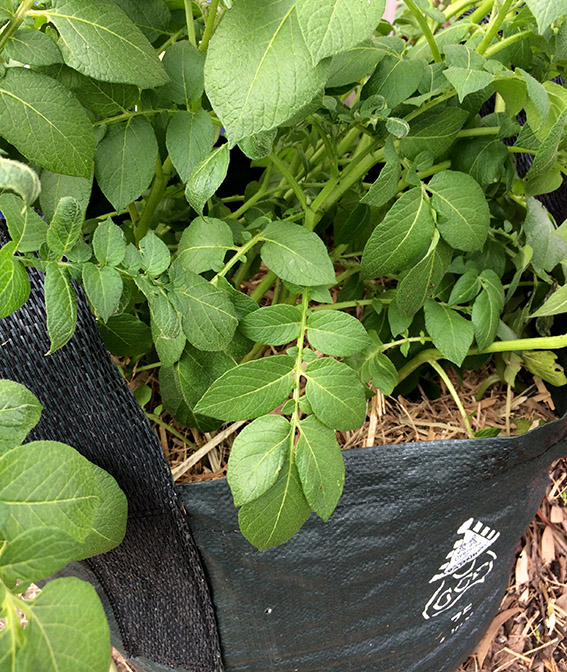
Growing potatoes in a Grow Bag
A few of our favourite potatoes
Kipfler – This small but vigorous potato produces long finger like potatoes with a delicious creamy yellow flesh. Perfect just boiled with butter and herbs or as an outstanding potato salad.
Sapphire – This unusual spud has purple skin and flesh which might just entice the kids into gardening and eating their veggies all at the same time
Nicola – A perfect all rounder spud, with a buttery, rich flesh. Perfect for mashing, baking, gnocchi and boiling.
Binjte – Looking for high yields and a potato that stores well – this is the spud for you. In the kitchen it’s an all purpose potato with a waxy, creamy yellow flesh. Stored correctly, Binjte lasts particularly well compared to other varieties.
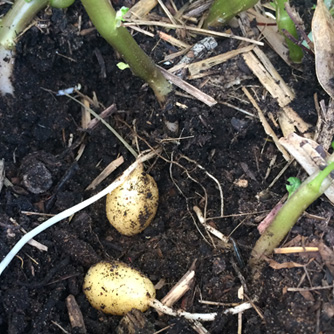
Baby chat potatoes developing


